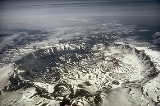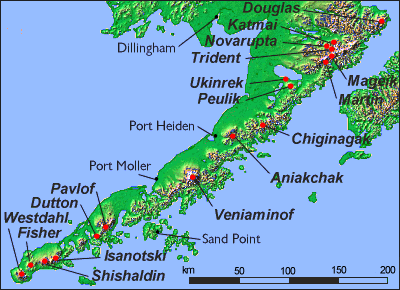
Mount Aniakchak
Encyclopedia
Mount Aniakchak is a 3,700 year old volcanic caldera
(about 10 kilometres (6 mi) in diameter) located in the Aleutian Range
of Alaska
, United States. The area around the volcano is the Aniakchak National Monument and Preserve
, maintained by the National Park Service
. In November 1967, Aniakchak Caldera was designated as a National Natural Landmark
by the National Park Service.
, which left evidence in ice cores dated to 1645 BC.
After the caldera forming events, from about 3500 years ago to the present, more than 20 eruptions occurred from vents on the caldera floor. Vent Mountain has been the source of numerous eruptions of ash, bombs, and lava flows since the formation of the caldera. From 1500 BCE to 1000 CE four lava domes were extruded on the caldera floor. Textural evidence indicates that these lava-dome eruptions occurred beneath Ancient Surprise Lake which was as deep as 100m. Ancient Surprise Lake drained catastrophically before about 1000 CE. (Surprise Lake is now about 2.75 km2 (680 acres) in area and up to 19.5 m (64.0 ft) deep.) Prior to or immediately after this draining, explosive eruptions of andesitic magma produced a cluster of three tuff cones in the southeastern part of the caldera.
Around 1500 CE, during one of the most violent events in recent history at Aniakchak, an estimated 0.75 to 1.0 km3 of material destroyed a preexisting edifice at Half Cone and inundated most of the caldera floor with pyroclastic flows, surges, and fallout many meters thick. During the final phase of this eruption, a lava flow filled the basin formed during the collapse of Half Cone.
Several more recent prehistoric eruptions occurred in the summit crater and along the south flank of Vent Mountain producing a field of blocky dacite lava flows against the south wall of the caldera. Minor eruptions immediately west and east of Vent Mountain produced a small scoria cone (Blocky Cone) and two maar craters (now water-filled) along the base of the southeast caldera wall.
European-descended geologists discovered the volcano in 1922.
The volcano's only eruption in historical time was that of 1931. The Jesuit priest Father Bernard Hubbard recorded it. "A small but impressive explosion pit was added to the pockmarked caldera floor that year. Many thousands of tons of ash lay strewn within the caldera and scattered up to 40 miles away over the small villages."
, a National Wild River.


Caldera
A caldera is a cauldron-like volcanic feature usually formed by the collapse of land following a volcanic eruption, such as the one at Yellowstone National Park in the US. They are sometimes confused with volcanic craters...
(about 10 kilometres (6 mi) in diameter) located in the Aleutian Range
Aleutian Range
The Aleutian Range is a major mountain range of southwest Alaska, extending from Chakachamna Lake to Unimak Island, at the tip of the Alaska Peninsula. It includes all of the mountains of the Peninsula. It is especially notable for its large number of active volcanoes, which are also part of the...
of Alaska
Alaska
Alaska is the largest state in the United States by area. It is situated in the northwest extremity of the North American continent, with Canada to the east, the Arctic Ocean to the north, and the Pacific Ocean to the west and south, with Russia further west across the Bering Strait...
, United States. The area around the volcano is the Aniakchak National Monument and Preserve
Aniakchak National Monument and Preserve
Aniakchak National Monument and Preserve is a U.S. National Monument and National Preserve, consisting of the region around the Aniakchak volcano on the Aleutian Range of south-western Alaska....
, maintained by the National Park Service
National Park Service
The National Park Service is the U.S. federal agency that manages all national parks, many national monuments, and other conservation and historical properties with various title designations...
. In November 1967, Aniakchak Caldera was designated as a National Natural Landmark
National Natural Landmark
The National Natural Landmark program recognizes and encourages the conservation of outstanding examples of the natural history of the United States. It is the only natural areas program of national scope that identifies and recognizes the best examples of biological and geological features in...
by the National Park Service.
Geological history
Aniakchak caldera formed during a major eruption of VEI=6Volcanic Explosivity Index
The Volcanic Explosivity Index was devised by Chris Newhall of the U.S. Geological Survey and Stephen Self at the University of Hawaii in 1982 to provide a relative measure of the explosiveness of volcanic eruptions....
, which left evidence in ice cores dated to 1645 BC.
After the caldera forming events, from about 3500 years ago to the present, more than 20 eruptions occurred from vents on the caldera floor. Vent Mountain has been the source of numerous eruptions of ash, bombs, and lava flows since the formation of the caldera. From 1500 BCE to 1000 CE four lava domes were extruded on the caldera floor. Textural evidence indicates that these lava-dome eruptions occurred beneath Ancient Surprise Lake which was as deep as 100m. Ancient Surprise Lake drained catastrophically before about 1000 CE. (Surprise Lake is now about 2.75 km2 (680 acres) in area and up to 19.5 m (64.0 ft) deep.) Prior to or immediately after this draining, explosive eruptions of andesitic magma produced a cluster of three tuff cones in the southeastern part of the caldera.
Around 1500 CE, during one of the most violent events in recent history at Aniakchak, an estimated 0.75 to 1.0 km3 of material destroyed a preexisting edifice at Half Cone and inundated most of the caldera floor with pyroclastic flows, surges, and fallout many meters thick. During the final phase of this eruption, a lava flow filled the basin formed during the collapse of Half Cone.
Several more recent prehistoric eruptions occurred in the summit crater and along the south flank of Vent Mountain producing a field of blocky dacite lava flows against the south wall of the caldera. Minor eruptions immediately west and east of Vent Mountain produced a small scoria cone (Blocky Cone) and two maar craters (now water-filled) along the base of the southeast caldera wall.
European-descended geologists discovered the volcano in 1922.
The volcano's only eruption in historical time was that of 1931. The Jesuit priest Father Bernard Hubbard recorded it. "A small but impressive explosion pit was added to the pockmarked caldera floor that year. Many thousands of tons of ash lay strewn within the caldera and scattered up to 40 miles away over the small villages."
Surprise Lake
Surprise Lake within the caldera is the source of the Aniakchak RiverAniakchak River
The Aniakchak River is a river in Lake and Peninsula Borough on the Alaska Peninsula. It arises in Surprise Lake in the Aniakchak National Monument and Preserve and flows eastward into Aniakchak Bay and the Pacific Ocean....
, a National Wild River.


See also
- List of National Natural Landmarks
- List of volcanoes in the United States of America
Sources
- Volcanoes of the Alaska Peninsula and Aleutian Islands-Selected Photographs
- Alaska Volcano Observatory

